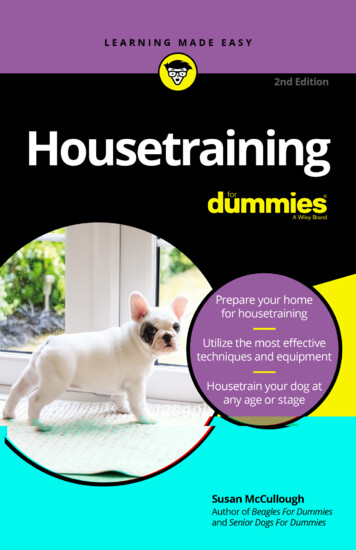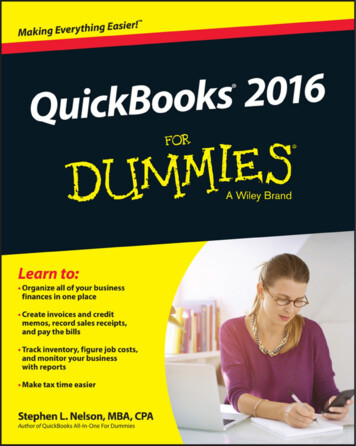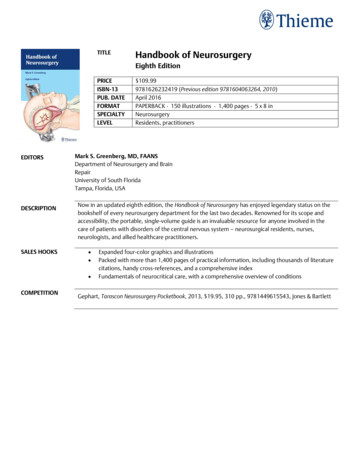
Transcription
Housetraining2nd Editionby Susan McCullough
Housetraining For Dummies , 2nd EditionPublished by: John Wiley & Sons, Inc., 111 River Street, Hoboken, NJ 07030-5774, www.wiley.comCopyright 2019 by John Wiley & Sons, Inc., Hoboken, New JerseyPublished simultaneously in CanadaNo part of this publication may be reproduced, stored in a retrieval system or transmitted in anyform or by any means, electronic, mechanical, photocopying, recording, scanning or otherwise,except as permitted under Sections 107 or 108 of the 1976 United States Copyright Act, withoutthe prior written permission of the Publisher. Requests to the Publisher for permission should beaddressed to the Permissions Department, John Wiley & Sons, Inc., 111 River Street, Hoboken, NJ07030, (201) 748-6011, fax (201) 748-6008, or online at http://www.wiley.com/go/permissions.Trademarks: Wiley, For Dummies, the Dummies Man logo, Dummies.com, Making EverythingEasier, and related trade dress are trademarks or registered trademarks of John Wiley & Sons,Inc., and may not be used without written permission. All other trademarks are the property oftheir respective owners. John Wiley & Sons, Inc., is not associated with any product or vendormentioned in this book.LIMIT OF LIABILITY/DISCLAIMER OF WARRANTY: THE PUBLISHER AND THE AUTHOR MAKE NOREPRESENTATIONS OR WARRANTIES WITH RESPECT TO THE ACCURACY OR COMPLETENESS OFTHE CONTENTS OF THIS WORK AND SPECIFICALLY DISCLAIM ALL WARRANTIES, INCLUDINGWITHOUT LIMITATION WARRANTIES OF FITNESS FOR A PARTICULAR PURPOSE. NO WARRANTYMAY BE CREATED OR EXTENDED BY SALES OR PROMOTIONAL MATERIALS. THE ADVICEAND STRATEGIES CONTAINED HEREIN MAY NOT BE SUITABLE FOR EVERY SITUATION. THISWORK IS SOLD WITH THE UNDERSTANDING THAT THE PUBLISHER IS NOT ENGAGED INRENDERING LEGAL, ACCOUNTING, OR OTHER PROFESSIONAL SERVICES. IF PROFESSIONALASSISTANCE IS REQUIRED, THE SERVICES OF A COMPETENT PROFESSIONAL PERSON SHOULD BESOUGHT. NEITHER THE PUBLISHER NOR THE AUTHOR SHALL BE LIABLE FOR DAMAGES ARISINGHEREFROM. THE FACT THAT AN ORGANIZATION OR WEBSITE IS REFERRED TO IN THIS WORKAS A CITATION AND/OR A POTENTIAL SOURCE OF FURTHER INFORMATION DOES NOT MEANTHAT THE AUTHOR OR THE PUBLISHER ENDORSES THE INFORMATION THE ORGANIZATIONOR WEBSITE MAY PROVIDE OR RECOMMENDATIONS IT MAY MAKE. FURTHER, READERSSHOULD BE AWARE THAT INTERNET WEBSITES LISTED IN THIS WORK MAY HAVE CHANGED ORDISAPPEARED BETWEEN WHEN THIS WORK WAS WRITTEN AND WHEN IT IS READ.For general information on our other products and services, please contact our Customer CareDepartment within the U.S. at 877-762-2974, outside the U.S. at 317-572-3993, or fax 317-5724002. For technical support, please visit www.wiley.com/techsupport.Wiley publishes in a variety of print and electronic formats and by print-on-demand. Somematerial included with standard print versions of this book may not be included in e-books orin print-on-demand. If this book refers to media such as a CD or DVD that is not included inthe version you purchased, you may download this material at http://booksupport.wiley.com.For more information about Wiley products, visit www.wiley.com.Library of Congress Control Number: 2019944086ISBN 978-1-119-61029-8 (pbk); ISBN 978-1-119-61032-8 (ebk); ISBN 978-1-119-61028-1 (ebk)Manufactured in the United States of America10 9 8 7 6 5 4 3 2 1
Contents at a GlanceIntroduction. 1Part 1: Preparing to Potty Train Your Pooch. 7CHAPTER 1:CHAPTER 2:CHAPTER 3:CHAPTER 4:No, Virginia, It’s Not That Hard: UnderstandingHousetraining Basics. 9Training the Housetrainer: Taking the Right Approach. 17Getting Your Home in Housetraining Order. 37Feeding Fido: What Goes In Must Come Out. 59Part 2: Putting a Plan in Place. 81CHAPTER 5:CHAPTER 6:CHAPTER 7:CHAPTER 8:Training to Love the Crate. 83Heading to the Outside: Outdoor Housetraining. 95Making Some Inside Moves: Indoor Housetraining.111Fine-Tuning Housetraining.129Part 3: Solving Housetraining Problems.143Accident-Proofing Small Dogs and Other Problem Potty-ers.145Understanding How an Oh-No Can Become a Problem-o.161CHAPTER 11: Sorting Out Humans’ Housetraining Challenges.175CHAPTER 9:CHAPTER 10:Part 4: The Part of Tens.191Ten Housetraining Mistakes You Don’t Have to Make.193CHAPTER 13: Ten Reasons Housetrained Dogs Live in Happier Households.201CHAPTER 12:Appendix: Other Helpful Pit Stopsfor Housetrainers.207Index.213
Table of ContentsINTRODUCTION. 1About This Book. 1Conventions Used in This Book. 2What You’re Not to Read. 3Foolish Assumptions. 4How This Book Is Organized. 4Part 1: Preparing to Potty Train Your Pooch. 5Part 2: Putting a Plan in Place. 5Part 3: Solving Housetraining Problems. 5Part 4: The Part of Tens. 5Appendix. 6Icons Used in This Book. 6Where to Go From Here. 6PART 1: PREPARING TO POTTY TRAIN YOUR POOCH. 7CHAPTER 1:No, Virginia, It’s Not That Hard:Understanding Housetraining Basics. 9What Housetraining Is — and Why It Matters. 10Why Your Dog Can’t Be “a Little Bit Housetrained”. 11Exploring Housetraining Methods. 12Location, location, location: Outdoor versusindoor training. 12Looking at lifestyle factors to help you chooseyour method. 14Surviving Setbacks and Special Situations. 15Understanding the Role You and Your Family Play. 15CHAPTER 2:Training the Housetrainer:Taking the Right Approach. 17Leaving behind Housetraining Methods of Yesteryear. 18Using Your Pooch’s Instincts to Lay a Foundation. 19The training your dog has already had. 19Learning from his mom. 21Denning dynamics. 22Cleanliness is next to dog-liness. 23Life without guilt. 24Table of Contentsv
Learning by repetition. 25The need for attachment. 26How instincts can be thwarted. 26Taking the 21st-Century Approach to Housetraining. 29Seeing your dog’s point of view. 30Being benevolent. 31Working with your dog’s instincts. 31Creating a schedule. 32Rewarding the good, ignoring the goofs. 32Being consistent. 34Attending to details. 35CHAPTER 3:Getting Your Home in Housetraining Order. 37Readying Your Dog’s Room: The Crate. 37Understanding why every dog needs (and wants) a crate. 38Finding the right fit: Types of crates. 38Adjusting for size. 40Investing in crate accessories. 41Situating your doggie’s den. 42Gearing Up for Outdoor Training. 42Selecting a potty spot — no matter where you live. 42Securing collars and leashes. 43Containing the situation: Fencing. 47Installing a doggie door. 48Prepping for Indoor Training. 49Exploring types of indoor potties. 50Setting up your dog’s indoor living area and potty spot. 50Doing the Dirty Work: Cleanup Equipment. 53Choosing an outdoor cleanup method. 53Indoor cleaners. 55Other cleaning aids. 57CHAPTER 4:Feeding Fido: What Goes In Must Come Out. 59Knowing How Feeding and Watering Affect Housetraining. 59Understanding Nutrients: What Dogs Need to Eat. 60Proteins. 61Fats. 62Vitamins and minerals. 62Determining the Diet That’s Best for Your Dog. 63Considering commercial dog foods. 64Making home-prepped dog foods. 66viHousetraining For Dummies
Serving Your Dog. 69Picking the place to feed your dog. 69Setting the canine dining ambience. 70Selecting your dog’s dinnerware. 71Deciding when to feed your dog. 72To Treat or Not to Treat. 74Buying commercial treats. 76Preparing homemade treats. 77Choosing low-calorie treat options. 78Working with Your Dog’s Drinking Habits. 80PART 2: PUTTING A PLAN IN PLACE. 81CHAPTER 5:Training to Love the Crate. 83Introducing the Crate. 84Tie one on: The open-door policy. 84Encourage exploration. 84Shut the door (but not for long). 86Leave the room. 86Build up her tolerance. 86Encouraging Appreciation If Your Dog Hates the Crate. 88Limiting Crate Time: How Much Is Too Much?. 90Continuing to Use the Crate. 92Keeping the love alive. 92Beyond housetraining: Other uses for the crate. 93CHAPTER 6:Heading to the Outside:Outdoor Housetraining. 95Understanding How Outdoor Training Works. 96Introducing Puppies to Outdoor Training. 96Getting an early start. 97Taking the first trips outside. 97Responding when your puppy potties. 98A matter of timing: Setting up a puppy potty schedule.100Scheduling Outdoor Training for Adult Dogs.104Dealing with Boo-Boos.105Catching your dog in the act.105Finding messes: Don’t scold — just clean ’em up!.105Preventing further accidents.106Providing Indoor Potty Areas for Outdoor Trainees.107Table of Contentsvii
CHAPTER 7:Making Some Inside Moves:Indoor Housetraining.111Understanding How Indoor Training Works.111Identifying good indoor-training candidates.112Opting for indoor training only.114Pick Your Potty: Deciding Which Type to Use.114Newspapers.115Puppy training pads.116Litter boxes.116Grate/tray potties.118Introducing Puppies to Indoor Training.119Deciding where to put the indoor potty.119Starting out.120Scheduling bathroom breaks.122Switching a vaccinated puppy to outdoor training.124Using Indoor Training for the Adult Dog.125From outdoors to papers.125From outdoors to litter box.126From outdoors to grate/tray combo.127Responding to Mistakes.128CHAPTER 8:Fine-Tuning Housetraining.129Decoding Pre-Potty Maneuvers.130Getting Your Dog to Ask to Go Out.132Encouraging Elimination.135Peeing on cue.136Prompting Mr. (or Ms.) Independent.137Deciding When to Grant More Freedom.139The age factor: How old is old enough?.140The responsibility factor: Should she have freedomof the house?.140PART 3: SOLVING HOUSETRAINING PROBLEMS.143CHAPTER 9:Accident-Proofing Small Dogsand Other Problem Potty-ers.145The Teensy-Weensy Tinkler.145Choose the right potty place.146Don’t push your luck (or her bladder).147Don’t excuse lapses.147viiiHousetraining For Dummies
The Dog Who Pees Lying Down.148Play it cool.148Get down to her level.149Don’t stare her down.150The Dog Who Leaves His Mark.150Neuter him.150Remove (or at least contain) the target.150Remind him who’s top dog.151Build a peaceable kingdom.151Start remedial housetraining.152The Uptight Canine.152The Dog Who Wants a New Bathroom.155The Dog Who Gets Distracted.155The Fair-Weather Piddler.156The Bedwetter.157The Dog Who Gets Amnesia.157The Dog Who Can’t Hold It.158Rule out other issues.158Find a holistic vet.158Consider diapers.159The Poop Eater.159The Bleeding Lady, or the Canine Fertility Goddess.160CHAPTER 10:Understanding How an Oh-No CanBecome a Problem-o.161A Whiz of a Problem.162Constant peeing.162Constant drinking and constant peeing.163Pee that comes out slowly or not at all.164Oddly colored pee.165The Scoop on Poop Problems.165Poop on the run(s).165Soft, stinky poop.167Oily poop.167Poop that comes out slowly or not at all.168Poop that contains other things.169Gray, black, or red poop.170Skinny poop.171Gaseous Emissions.173Table of Contentsix
CHAPTER 11:Sorting Out Humans’ HousetrainingChallenges.175Crafting a Family Housetraining Plan.176Dividing duties: A plan to relieve the primary caregiver.176Getting the adults on the same page.177Getting the kids on board.178Balancing Crate Time.179Relieving the Home-Alone Dog.180Getting a pet-sitter or dog walker.181Bringing your dog to work.181Going home for lunch.182Working from home.182Creating a potty-proof home-alone area.182Sticking to the Schedule.183Managing Snacks.184Messing Up the Cleanup.185Anticipating Lapses Due to Household Changes.186Helping the Newly Adopted Housetrainee.187Hitting the Road with Your Housetraining Graduate.189PART 4: THE PART OF TENS.191CHAPTER 12:Ten Housetraining MistakesYou Don’t Have to Make.193Thinking the Crate Is Cruel.193Getting a Crate That’s Too Big.194Failing to Stick to the Schedule.195Failing to Clean Up Completely.196Not Cleaning the Indoor Potty.196Thinking Your Dog Looks Guilty.197Scolding Her after the Fact.198Rubbing His Nose in You-Know-What.198Changing the Menu Abruptly.199Declaring Victory Prematurely.200CHAPTER 13:Ten Reasons Housetrained DogsLive in Happier Households.201The Houses Smell Nicer.201The Owners Save Money.202The Owners Are Less Cranky.202xHousetraining For Dummies
The Dogs Aren’t Scared When Their Owners Come Home.202The Owners Don’t Worry about Stepping in You-Know-What.203The Dogs Have One Less Way to Embarrass Their Owners.204The Owners Know Right Away When Their Dogs Are Sick.204The Dogs Have a Great Foundation for Further Training.205Dogs and Owners Communicate Better with Each Other.205The Owners Are More Likely to Keep Their Dogs.206APPENDIX: OTHER HELPFUL PIT STOPSFOR HOUSETRAINERS.207Go Online.207Book ’Em!.209Flip through These Mags.210INDEX.213Table of Contentsxi
IntroductionWhen you brought home that adorable little puppy ornoble-looking adult dog, you undoubtedly were lookingforward to a lifetime of love, devotion, and companionship. Maybe you wanted a dog to jog with in the morning, havecurl up at your feet in the evening, or talk to during the day.Perhaps you were looking forward to heaping lots of unconditional love upon a hard-luck rescue dog who hadn’t known suchlove before. Or maybe you remembered watching Lassie when youwere a kid and were hoping that your new family member couldbe the same sort of friend-of-a-lifetime that the famous Colliewas for little Timmy.Every new relationship between a person and a dog starts out withat least a little bit of fantasizing on the part of the person. Soonthereafter, though, reality intrudes upon those fantasies. All toooften, that intrusion takes the form of a puddle or pile depositedon the floor of your home. The puddle is gross. The pile stinks.Both leave stains. And you are totally grossed out.Loving a pooch who turns your nicely decorated home into a canineouthouse is tough. But this problem doesn’t have to h appen. Youjust need to teach your dog proper potty manners. In other words,you need to housetrain him.When your dog is housetrained, both of your lives become a wholelot easier and immeasurably more satisfying. Gone are the doggieaccidents, stains, and smells that keep professional carpet cleaners in business but all too often ruin the precious bonds betweendogs and their people. I’ve written this book to make sure that youand your dog maintain those bonds.About This BookHousetraining For Dummies, 2nd Edition, is a reference bookdesigned to help you not only teach your dog the ins and outs ofbasic bathroom behavior but also prevent your pooch from developing potty problems — or solve any problems she already has.Introduction1
Whether you have a brand-new puppy who’s piddling on yourequally new Oriental rug; an unruly adolescent male dog who’spracticing leg-lifts (and subsequent anointings) right next toyour antique loveseat; a matronly female dog who’s wetting herbed while she sleeps; or simply a pooch who never seems to knowwhat he’s supposed to do when you take him out, this book canhelp you sort out your dog’s bathroom issues and resolve them,no matter what they are.You don’t have to read this book from start to finish to teach yourcanine companion proper potty deportment. If you want to knoweverything and then some about housetraining, begin readinghere and plow through to the end. But if you have a specific concern, such as wanting to teach your dog to tell you when she needsto go out, skip the preliminaries, look over the table of contents,and proceed to the chapter that tells you exactly what you wantto know.Finally, this book is meant to be a guide but not a substitute forthe up-close-and-personal advice that other experts such asveterinarians, trainers, and behaviorists give. If the suggestionshere don’t work for you and your dog, or if you have a questionthat this book doesn’t cover, don’t hesitate to contact any of theseprofessionals.Conventions Used in This BookTo help you find your way through this book — as in allFor Dummies books — I’ve used the following conventions:»» Italics highlight new words and terms.»» Boldfaced text indicates the actions in numbered steps andkeywords in bulleted lists.»» Monofont indicates a web address.In addition, I’ve added some conventions of my own. For onething, I’m not even going to try to sound genteel in this book —after all, you’re dealing with bodily waste here. That’s whyI refer to canine bodily byproducts as poop and pee — althoughI occasionally substitute other terms just for the sake of variety.2Housetraining For Dummies
At the same time, I refrain from using other terms commonlyemployed in discussions of pooch potty protocol. Specifically,I don’t use the words housebreak, housebreaking, or housebrokenanywhere in this book, except when I describe the history ofcanine toilet training. That’s because when you teach your dogsto eliminate appropriately, you’re not breaking anything. In fact,you’re doing quite the opposite: By teaching the dog to poop andpee when and where you want him to, you’re building bondsbetween you two. You’re laying the foundation for a loving, longlasting relationship.Finally, there’s the matter of gender. Many writers like to referto canine companions in gender-neutral terms such as it unlessdiscussing a specific dog, such as Daisy or Max. But I don’t agreewith them. Any dog, even if spayed or neutered, has a clear gender. More importantly, every dog is a living being who deservesthe dignity of being referred to as such. For that reason, I use theword who, not that, along with he, she, him, her, his, and hers torefer to canine companions. I tend to alternate the genders of theexample dogs in a chapter, so any of those pronouns (or a namesuch as Fido or Lassie) applies to dogs of either gender unless Iindicate otherwis
vi Housetraining For Dummies Learni










